英语时态标志词word版本
关于时态的标志词

关于时态的标志词时态是英语语法的重要部分,它描述动作和状态发生的时间。
在使用时态时,我们可以通过一些标志词来帮助我们判断应该使用哪种时态。
下面是针对不同时态的标志词列表,希望对你的英语写作能够有所帮助。
一、一般现在时:1. Always2. Usually3. Often4. Sometimes5. Seldom6. Rarely7. Never8. Every day/week/month/year9. On Mondays/Tuesdays/etc.10. In the morning/afternoon/evening二、进行时:1. Right now2. At the moment3. Currently4. Today5. Tonight6. This week/month/year7. At this time8. Nowadays三、一般过去时:1. Yesterday2. Last week/month/year3. In 1999/2002/etc.4. When I was a child5. At that time6. In the past四、过去进行时:1. At 8:00 last night2. At this time yesterday3. While I was walking4. During the party last night五、将来时:1. Tomorrow2. Next week/month/year3. In five years4. Soon5. Later6. At some point in the future7. In the near/distant future六、将来进行时:1. At 10:00 tonight2. Next week at this time3. In two years' time4. In the future七、现在完成时:1. Already2. Yet3. Just4. In the past few days/weeks/months/years5. So far6. Since I arrived/started/etc.7. For a long/short time八、过去完成时:1. Before2. By the time3. After4. When5. Already6. Just7. Had not...yet九、情态动词:1. Can2. Could3. May4. Might5. Must6. Shall7. Should8. Will9. Would。
(完整word版)英语时态标志词

(完整word版)英语时态标志词动词时态标志词1.一般现在时(1) always, usually, often, sometimes(2) every day, every morning, every Saturday, every time(3) in the morning, on Saturdays(4) once a week, three times a day, twice a year2.一般过去时(1) yesterday, the day before yesterday,yesterday morning (evening, afternoon)(2) last time, last Friday, last term, last month(3) 一段时间+ago(4) just now = a moment ago(5)in 1989(6)at the age of 5,one day, long long ago, once upon a time(7) in the past3.现在进行时(1)now. nowadays (2)these days at present(3)Look. Listen.4.过去进行时(1)at that time.at that moment.this time yesterday evening(2)以when引导的谓语动词是一般过去时的时间状语5.一般将来时(1) tomorrow, the day after tomorrow,tomorrow morning (evening, afternoon)(2) next time, next Friday, next term, next month(3) in+一段时间in + 一段时间 ' s + time(4) soon = right away = at once(5) by the end of + 将来时间6.过去将来时(1)the next time Friday term month(2)the following month (week…),7..现在完成时(1) already, yet, ever, never, just, before(2) for + 一段时间,since + 过去某一点时间since +从句(一般过去式);since + 一段时间 + agoin / during the past / last + 一段时间(3)recently ,lately(4)so far8..过去完成时(1).by, by the time (of), by the end of + 过去时间(2)when. before. after…….+过去时间(3)up till then (直到那时); up until last night(直到昨晚)等。
英语各个时态的句子结构及标志词
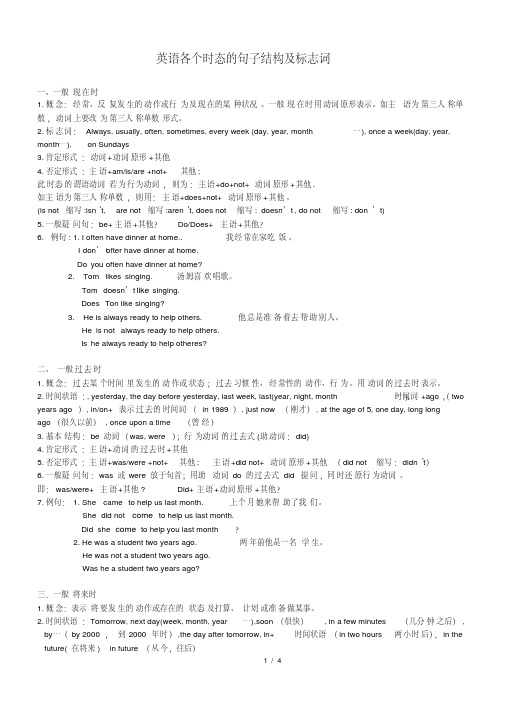
英语各个时态的句子结构及标志词一、一般现在时1.概念:经常、反复发生的动作或行为及现在的某种状况。
一般现在时用动词原形表示。
如主语为第三人称单数,动词上要改为第三人称单数形式。
2.标志词:Always, usually, often, sometimes, every week (day, year, month…), once a week(day, year, month…), on Sundays3.肯定形式:动词+动词原形+其他4.否定形式:主语+am/is/are +not+其他;此时态的谓语动词若为行为动词,则为:主语+do+not+动词原形+其他,如主语为第三人称单数,则用:主语+does+not+动词原形+其他。
(is not缩写:isn’t, are not缩写:aren’t, does not缩写: doesn’t , do not 缩写: don’t)5.一般疑问句:be+主语+其他?Do/Does+主语+其他?6. 例句: 1. I often have dinner at home.. 我经常在家吃饭。
I don’tofter have dinner at home.Do you often have dinner at home?2.Tom likes singing. 汤姆喜欢唱歌。
Tom doesn’t like singing.Does Ton like singing?3.He is always ready to help others. 他总是准备着去帮助别人。
He is not always ready to help others.Is he always ready to help otheres?二、一般过去时1.概念:过去某个时间里发生的动作或状态;过去习惯性、经常性的动作、行为。
用动词的过去时表示。
时间词+ago,(two 2.时间状语:, yesterday, the day before yesterday, last week, last(year, night, month…),years ago), in/on+表示过去的时间词(in 1989), just now(刚才), at the age of 5, one day, long longago(很久以前), once upon a time(曾经)3.基本结构:be动词(was, were);行为动词的过去式(助动词:did)4.肯定形式:主语+动词的过去时+其他5.否定形式:主语+was/were +not+其他; 主语+did not+动词原形+其他(did not 缩写:didn’t)6.一般疑问句:was或were放于句首;用助动词do的过去式did 提问,同时还原行为动词。
英语八大时态标志词及结构表
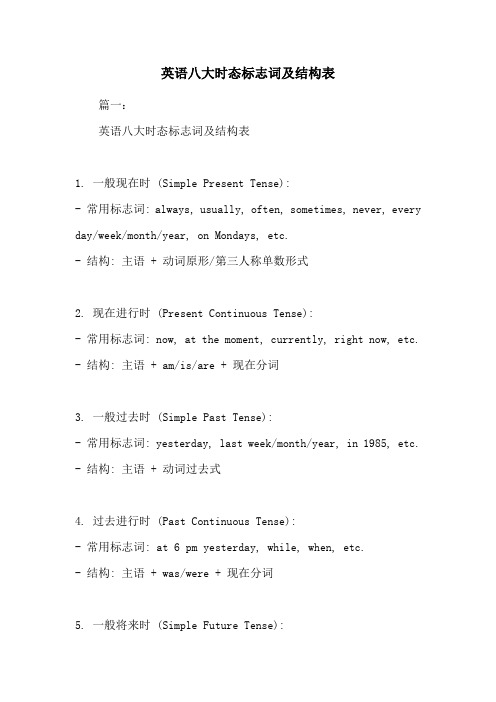
英语八大时态标志词及结构表篇一:英语八大时态标志词及结构表1. 一般现在时 (Simple Present Tense):- 常用标志词: always, usually, often, sometimes, never, every day/week/month/year, on Mondays, etc.- 结构: 主语 + 动词原形/第三人称单数形式2. 现在进行时 (Present Continuous Tense):- 常用标志词: now, at the moment, currently, right now, etc. - 结构: 主语 + am/is/are + 现在分词3. 一般过去时 (Simple Past Tense):- 常用标志词: yesterday, last week/month/year, in 1985, etc. - 结构: 主语 + 动词过去式4. 过去进行时 (Past Continuous Tense):- 常用标志词: at 6 pm yesterday, while, when, etc.- 结构: 主语 + was/were + 现在分词5. 一般将来时 (Simple Future Tense):- 常用标志词: tomorrow, next week/month/year, in the future, etc.- 结构: 主语 + will + 动词原形6. 将来进行时 (Future Continuous Tense):- 常用标志词: this time next week/month/year, at 8 pm tomorrow, etc.- 结构: 主语 + will be + 现在分词7. 现在完成时 (Present Perfect Tense):- 常用标志词: already, yet, just, ever, never, so far, etc. - 结构: 主语 + have/has + 过去分词8. 过去完成时 (Past Perfect Tense):- 常用标志词: by the time, before, after, etc.- 结构: 主语 + had + 过去分词以上是英语八大时态标志词及其对应结构表。
英语各时态标志词
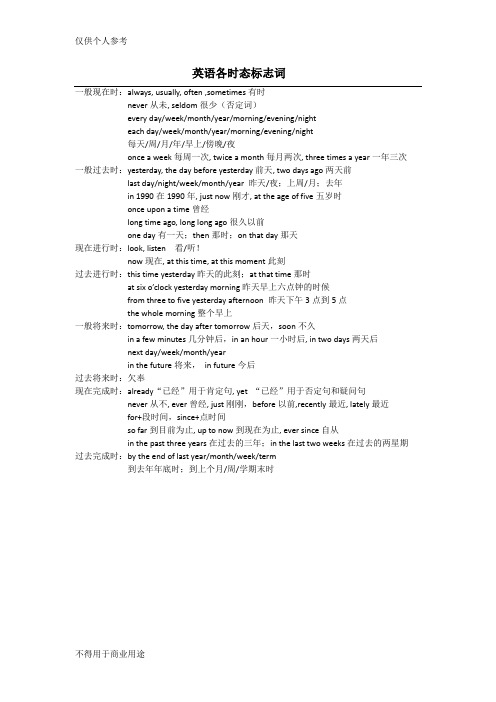
英语各时态标志词一般现在时:always, usually, often ,sometimes有时never从未, seldom很少(否定词)every day/week/month/year/morning/evening/nighteach day/week/month/year/morning/evening/night每天/周/月/年/早上/傍晚/夜once a week每周一次, twice a month每月两次, three times a year一年三次一般过去时:yesterday, the day before yesterday前天, two days ago两天前last day/night/week/month/year 昨天/夜;上周/月;去年in 1990在1990年, just now刚才, at the age of five五岁时once upon a time曾经long time ago, long long ago很久以前one day有一天;then那时;on that day那天现在进行时:look, listen 看/听!now现在, at this time, at this moment此刻过去进行时:this time yesterday昨天的此刻;at that time那时at six o’clock yesterday morning昨天早上六点钟的时候from three to five yesterday afternoon 昨天下午3点到5点the whole morning整个早上一般将来时:tomorrow, the day after tomorrow后天,soon不久in a few minutes几分钟后,in an hour一小时后, in two days两天后next day/week/month/yearin the future将来,in future今后过去将来时:欠奉现在完成时:already“已经”用于肯定句, yet “已经”用于否定句和疑问句never从不, ever曾经, just刚刚,before以前,recently最近, lately最近for+段时间,since+点时间so far到目前为止, up to now到现在为止, ever since自从in the past three years在过去的三年;in the last two weeks在过去的两星期过去完成时:by the end of last year/month/week/term到去年年底时;到上个月/周/学期末时仅供个人用于学习、研究;不得用于商业用途。
八种时态常用的标志词

四种时态常用的标志词1、一般现在时表示:现阶段经常发生的动作或存在的状态标志:often、usually、always、sometimes、everyday、inthemorning/afternoon onSun days,o nceaweek e.g. : Wegotoschoolatsixfortyeveryday.Mybrotherreadsabook on ceaweek.注意变三单2、一般将来时表示:将要发生的动作或存在的状态e.g. : Hewillgotoseeadoctortomorrow.Iamgoi ngtoplaybasketball nextweek.Sheisco min gback inan hour.3、一般过去时表示:过去发生的动作或存在的状态fin ally just now 标志:yesterday、lastweek、threedaysago、thedaybeforeyesterday,in1990e.g. : Ifinishedmyworkyesterday. Hewe nttoNew Yo rkte ndaysago.4、现在进行时表示:现在正在进行的动作It' eighto c lock.TheSmithsarewatchingTVinthelivingroom.注情态动词后用动词原形形容词、动词。
名词、副词互相转换1. trader (名词)动词贸易―trade2.health 名词healthy 形容词healthily3.die 动词dead 形容词dealth名词4 I oudly 副词loud 形容词5 quietly 副词quiet 形容词6 clearly 副词clear^形talent名形容8.Truly 畐H词true 动词truth 名词9.serious 形容词seriously 畐H词10.different 形-容词difference 名词fortable 形容词Comfortably 副词12.cheap 形容词cheaply 副词13.expensive 形容词14.careful 形容词carefully 副词15.careless 形容词carelessly 副词16.Discussion—名词discuss 动词17.successful—形容词succeed 动词success 名词。
(完整word版)八大时态标志词

(完满word版)八大时态标志词一般现在时标志词:every day,evry Sunday,often,always,usually,sometimes ,on Sundays, on weekdays等等。
一般过去时标志词:ago, yesterday,the day before yesterday,last week/year/night/month...,in 1989, just now,at the age of ,one day ,ago, long ago,once upon a time,(从前,许久从前)then( 那时 ), on that day (在那天) ,一般将来时标志词:soon, tomorrow, the day after tomorrow (后天),this evening/afternoon/yearbefore long( 不久今后),next year/month/week/summer , in the future,some day(将来的某一天 ) ,in two weeks/days/years现在进行时标志词:now. Look . Listen. these days,at that time.at that moment.this time,yesterday evening过去进行时标志词:at that time. at that moment. this time yesterday evening 等;也许与when, while, as 引导的过去时间状语连用。
现在完成时标志词:already(用于必定句), yet (用于否定,疑句), just, before, recently,still, lately,never, ever, never, twice, on several occasion, in the past few days/weeks/months/years, (up to)these fewdays/weeks/months/years, this morning/week/month/year, just,up to present, so far, up to now, till now, since+过去完成志:by, by the time (of), by the end of +去;when. before.after ⋯⋯ .+ 去;up till then ( 直到 ); up until last night( 直到昨晚)等;already, just, ever, yet等。
动词时态节构标志词
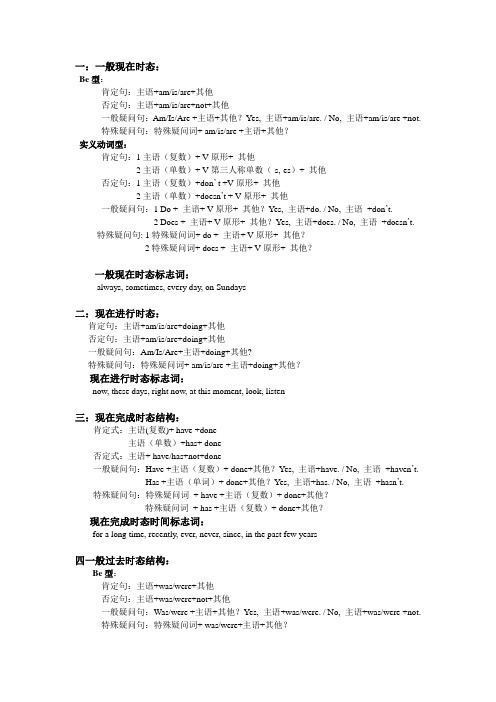
一:一般现在时态:Be型:肯定句:主语+am/is/are+其他否定句:主语+am/is/are+not+其他一般疑问句:Am/Is/Are +主语+其他?Yes, 主语+am/is/are. / No, 主语+am/is/are +not.特殊疑问句:特殊疑问词+ am/is/are +主语+其他?实义动词型:肯定句:1主语(复数)+ V原形+ 其他2主语(单数)+ V第三人称单数(-s,-es)+ 其他否定句:1主语(复数)+don’ t +V原形+ 其他2主语(单数)+doesn’t + V原形+ 其他一般疑问句:1 Do + 主语+ V原形+ 其他?Yes, 主语+do. / No, 主语+don’t.2 Does + 主语+ V原形+ 其他?Yes, 主语+does. / No, 主语+doesn’t.特殊疑问句: 1特殊疑问词+ do + 主语+ V原形+ 其他?2特殊疑问词+ does + 主语+ V原形+ 其他?一般现在时态标志词:always, sometimes, every day, on Sundays二:现在进行时态:肯定句:主语+am/is/are+doing+其他否定句:主语+am/is/are+doing+其他一般疑问句:Am/Is/Are+主语+doing+其他?特殊疑问句:特殊疑问词+ am/is/are +主语+doing+其他?现在进行时态标志词:now, these days, right now, at this moment, look, listen三:现在完成时态结构:肯定式:主语(复数)+ have +done主语(单数)+has+ done否定式:主语+ have/has+not+done一般疑问句:Have +主语(复数)+ done+其他?Yes, 主语+have. / No, 主语+haven’t.Has +主语(单词)+ done+其他?Yes, 主语+has. / No, 主语+hasn’t.特殊疑问句:特殊疑问词+ have +主语(复数)+ done+其他?特殊疑问词+ has +主语(复数)+ done+其他?现在完成时态时间标志词:for a long time, recently, ever, never, since, in the past few years四一般过去时态结构:Be型:肯定句:主语+was/were+其他否定句:主语+was/were+not+其他一般疑问句:Was/were +主语+其他?Yes, 主语+was/were. / No, 主语+was/were +not.特殊疑问句:特殊疑问词+ was/were+主语+其他?实义动词型:肯定句:主语+V-ed +其他否定句:主语+ didn’t + V原形+ 其他一般疑问句:Did + 主语+ V原形+ 其他?Yes, 主语+did. / No, 主语+didn’t.特殊疑问句: 特殊疑问词+ did+ 主语+ V原形+ 其他?一般过去时态时间标志词:yesterday, just now, last month, in 1996五过去进行时态:肯定句:主语+was/were+doing+其他否定句:主语+was/were+doing+其他一般疑问句:Was/were+主语+doing+其他?特殊疑问句:特殊疑问词+ was/were +主语+doing+其他?过去进行时态标志词:then, at that time, at seven yesterday, the whole day, at this time last night.六过去完成时态结构:肯定式:主语+ had+ done否定式:主语+ had+not+done一般疑问句:Had+主语(复数)+ done+其他?Yes, 主语+had. / No, 主语+hadn’t.特殊疑问句:特殊疑问词+ had +主语(复数)+ done+其他?过去完成时态时间标志词:by last week, by the end of last year, b y the time…..七一般将来时态结构:Will/shall型:肯定句:主语+will/shall + V原形+ 其他否定式:主语+will/shall + not+V原形+ 其他一般疑问句:Will/Shall +主语+ V原形+ 其他?Yes, 主语+will/shall. / No, 主语+will/shall + not.特殊疑问句: 特殊疑问词+ will/shall+ 主语+ V原形+ 其他?。
英语动词时态表.doc
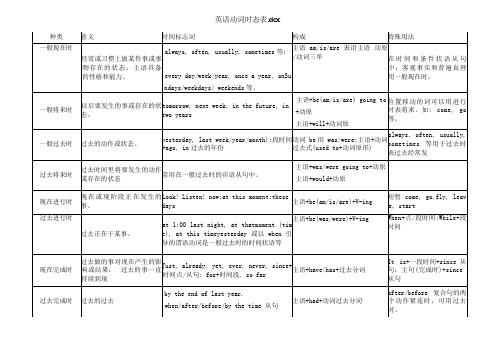
after/before复合句的两个动作紧连时,可用过去时。
英语动词时态表.doc
在时间和条件状语从句中:客观事实和普遍真理用一般现在时。
一般将来时
以后要发生的事或存在的状态。
tomorrow, nextweek, in the future, in two years
主语+be(am/is/are) going to+动原
主语+will+动词原
位置移动的词可以用进行时表将来。如: come, go等。
Just, already, yet, ever, never, since+时间点/从句: for+时间段, so far
主语+have/has+过去分词
It is+一段时间+since从句:主句(完成时)+since从句
过去完成时
过去的过去
by the end of last year.
when/after/before/by the time从句
过去进行时
过去正在干某事。
at 1:00 last night, at thatmoment (time),at this timeyesterday或以when引导的谓语动词是一般过去时的时间状语等
主语+be(was/were)+V-ing
When+点/段时间:While+段时间
现在完成时
过去做的事对现在产生的影响或结果:过去的事一直持续到现
种类
意义
时间标志词
构成
特殊用法
一般现在时
经常或习惯上做某件事或事物存在的状态:主语具备的性格和能力。
(完整word版)八大时态标志词
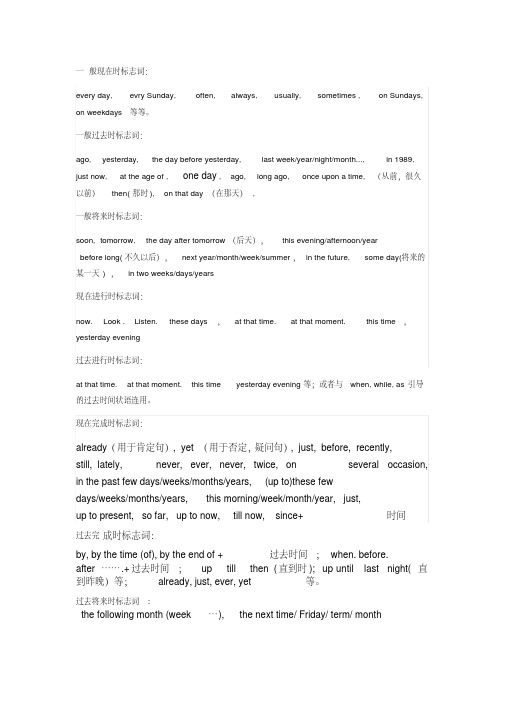
一般现在时标志词:every day, evry Sunday, often, always, usually, sometimes , on Sundays,on weekdays等等。
一般过去时标志词:ago, yesterday, the day before yesterday, last week/year/night/month..., in 1989,just now, at the age of , one day, ago, long ago, once upon a time,(从前,很久以前)then(那时), on that day(在那天),一般将来时标志词:soon, tomorrow, the day after tomorrow(后天),this evening/afternoon/yearbefore long(不久以后),next year/month/week/summer,in the future, some day(将来的某一天) ,in two weeks/days/years现在进行时标志词:now. Look. Listen. these days ,at that time. at that moment. this time ,yesterday evening过去进行时标志词:at that time. at that moment. this time yesterday evening等;或者与when, while, as引导的过去时间状语连用。
现在完成时标志词:already(用于肯定句), yet(用于否定,疑问句), just, before, recently,still, lately, never, ever, never, twice, on several occasion, in the past few days/weeks/months/years, (up to)these fewdays/weeks/months/years, this morning/week/month/year, just,up to present, so far, up to now, till now, since+时间过去完成时标志词:by, by the time (of), by the end of + 过去时间; when. before. after…….+过去时间; up till then (直到时); up until last night(直到昨晚)等; already, just, ever, yet 等。
(完整word版)初中英语时态标志词+例句
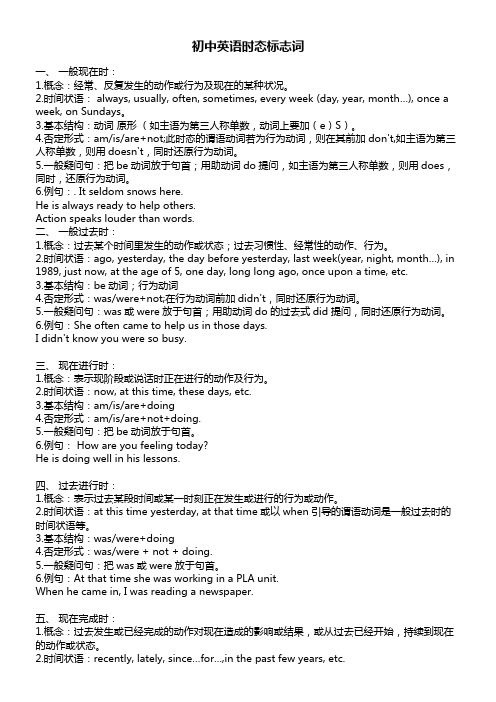
初中英语时态标志词一、一般现在时:1.概念:经常、反复发生的动作或行为及现在的某种状况。
2.时间状语: always, usually, often, sometimes, every week (day, year, month…), once a week, on Sundays。
3.基本结构:动词原形(如主语为第三人称单数,动词上要加(e)S)。
4.否定形式:am/is/are+not;此时态的谓语动词若为行为动词,则在其前加don't,如主语为第三人称单数,则用doesn't,同时还原行为动词。
5.一般疑问句:把be动词放于句首;用助动词do提问,如主语为第三人称单数,则用does,同时,还原行为动词。
6.例句:. It seldom snows here.He is always ready to help others.Action speaks louder than words.二、一般过去时:1.概念:过去某个时间里发生的动作或状态;过去习惯性、经常性的动作、行为。
2.时间状语:ago, yesterday, the day before yesterday, last week(year, night, month…), in 1989, just now, at the age of 5, one day, long long ago, once upon a time, etc.3.基本结构:be动词;行为动词4.否定形式:was/were+not;在行为动词前加didn't,同时还原行为动词。
5.一般疑问句:was或were放于句首;用助动词do的过去式did 提问,同时还原行为动词。
6.例句:She often came to help us in those days.I didn't know you were so busy.三、现在进行时:1.概念:表示现阶段或说话时正在进行的动作及行为。
英语时态标志词.docx
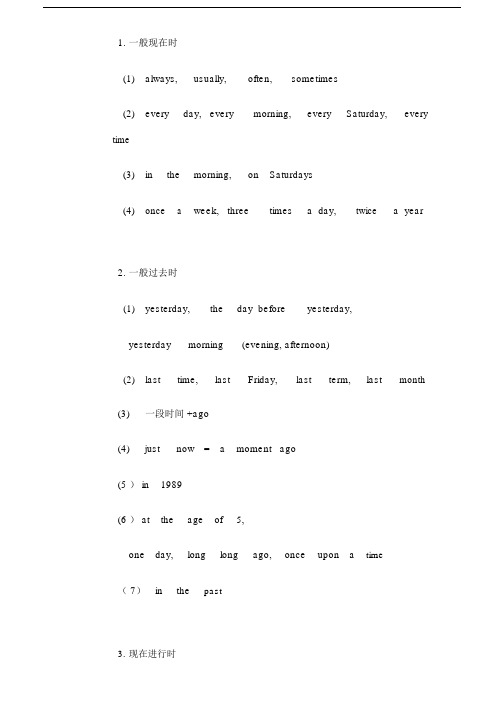
1.一般现在时(1)always,usually,often,sometimes(2)every day, every morning,every Saturday,every time(3)in the morning,on Saturdays(4)once a week, three times a day,twice a year2.一般过去时(1)yesterday,the day before yesterday,yesterday morning(evening, afternoon)(2)last time,last Friday,last term,last month(3)一段时间 +ago(4)just now = a moment ago(5 ) in 1989(6 ) at the age of5,one day, long long ago, once upon a time( 7)in the past3.现在进行时( 1) now. nowadays(2)these days at present (3) Look. Listen.4.去行(1)at that that time yesterday evening(2)以 when 引的是一般去的状5.一般将来(1)tomorrow, the day after tomorrow,tomorrow morning (evening,afternoon)(2)next time,next Friday,next term,next month(3)in+ 一段in +一段' s +time(4)soon = right away = at once(5)by the end of +将来6.去将来(1)the next time Friday term month(2)the following month (week⋯),7.. 在完成(1) already,yet,ever,never,just,before(2)for + 一段 , since +去某一点since+从句(一般去式);since+一段+ agoin / during the past / last+一段( 3) recently,lately( 4) so far8.. 去完成(1 ) .by,by the time (of),by the end of +去(2 ) when. before.after ⋯⋯ .+ 去(3)up till then (直到那);up until last night( 直到昨晚)等。
时态的标志词

时态的标志词:时间状语。
1一般现在时:always/usually/often/sometimes/hardly ever/hardly/never every dayonce a week /twice a week 提问how oftenIn the morning/afternoon/e evening/ on Sundaysif till until unless when as soon as2一般过去时yesterday the day before yesterday =the other day前a few minutes agojust now 刚才last Sunday /last week this morning often/…+过去时间on Sunday on Monday3一般将来时tomorrow/ 明天the day after tomorrow后天next year 明年/ next Sunday in a few days /in two days(How soon)in the future 将来before long 不久= soon this evening 今晚by the end of this term4.过去将来said /told ------tomorrow/ the next week.5.现在进行时now = at the moment= at this time 就在现在at present 目前these days 这些天look, listen It’s six now6.过去进形时then =at the time 在那时this time yesterday昨天的这个时候from 7to eight last night at five yesterday昨天5点7.现在完成时1)just 刚刚already已经yet(问,否)还never 从不ever 疑问before以前rencetly最近2)twice /three times how many times ( have been to )3)for /since 过完since +从句+p.4)sofar 目前in the last few years 最近几年for years 数年8.过去完成时by that time 到那个时候by the end of last week 到上周末She said hHe told +3.现在进行时:am/is/are working 4过去进行时:was/were working5.一般将来时will/shall/is,am ,are going to work6.过去将来时:would work/was/were going to7.现在完成时has/have+worked 8过去完成时had worked现在进行完成时:has/have been workinghall/is,am ,are going to work过去进行时:was/were workingShall I/we… ? shall 只能与I/we 连用被动语态重点考:一般现在:am/is /are done一般过去:was/were done一般将来:will be+done1._____ you______ (clean) the room now? No, I____2._______ you ____(clean) the room every day.? Yes ,______3.I’m _________ (watch)4.Is Jim _______ (do) his homework? Yes,_____.5.Lilly and Lucy __________-(clean).now6.She ___________ (not read) now. She _________(do) her homework7.Loo k!They _________ (take)photos .8.Look !The cat _________(run) up the tree9.Listen!Who_________ (sing).10.Listen!The birds_________(sing)11.It’s six o’clock now We ________(have) dinner at home.12._____your father and mother _______(read)books/yes , ______13.Your friends ________(wait) for you.now.情态动词should /can / may / must +doneI. 句型转换1. The children had a good time in the park.否定句:__________________________________________一般疑问句:________________________________________对划线部分提问:____________________________________2. There were about nine hundred people at the concert.(音乐会) 否定句:__________________________________________一般疑问句:________________________________________ 对划线部分提问:____________________________________ 3. There was only one problem.否定句:__________________________________________ 一般疑问句:________________________________________ 肯定/否定回答:____________________________________ 4. Ann did her homework yesterday evening.否定句:__________________________________________ 一般疑问句:________________________________________ 对划线部分提问:____________________________________ 5. Last week I read an English book.否定句:__________________________________________ 一般疑问句:________________________________________ 肯定/否定回答:____________________________________ 对划线部分提问:____________________________________ 6. My brother was in the park just now.否定句:__________________________________________ 一般疑问句:________________________________________ 肯定/否定回答:____________________________________ 对划线部分提问:____________________________________7. She had some bread for lunch today.否定句:__________________________________________一般疑问句:________________________________________肯定/否定回答:____________________________________对划线部分提问:____________________________________8. They read English last night.否定句:__________________________________________一般疑问句:________________________________________肯定/否定回答:____________________________________对划线部分提问:____________________________________、写出下列动词的三单现、过去式和现在分词go ______ _______ _______ enjoy _______ _______ ________buy ______ ______ _______ eat______ _______ _______get _______ _______ _______ walk ________ _______ ________take______ ______ ______ dance_______ ________ _______write _______ ______ ______ run______ _______ _______swim_______ _______ _______ find _______ _______ _______begin______ ______ ______ eat ______ _______ ______play ______ ______ _______ study ______ ______ ________III. 用所给词的适当形式填空。
英语各时态标志词
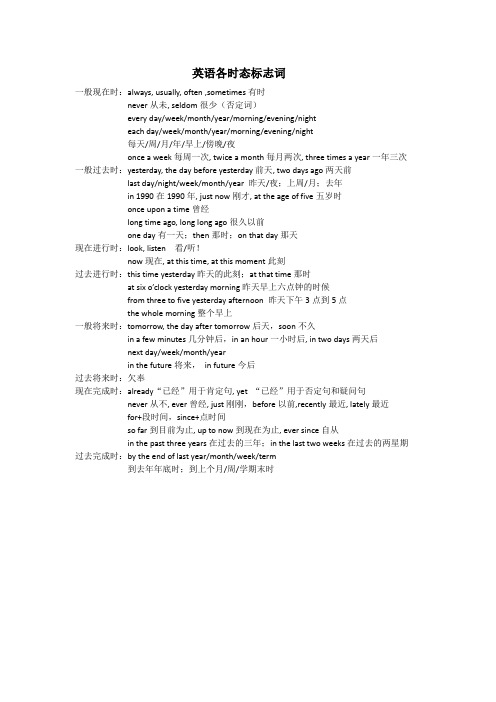
英语各时态标志词一般现在时:always, usually, often ,sometimes有时never从未, seldom很少(否定词)every day/week/month/year/morning/evening/nighteach day/week/month/year/morning/evening/night每天/周/月/年/早上/傍晚/夜once a week每周一次, twice a month每月两次, three times a year一年三次一般过去时:yesterday, the day before yesterday前天, two days ago两天前last day/night/week/month/year 昨天/夜;上周/月;去年in 1990在1990年, just now刚才, at the age of five五岁时once upon a time曾经long time ago, long long ago很久以前one day有一天;then那时;on that day那天现在进行时:look, listen 看/听!now现在, at this time, at this moment此刻过去进行时:this time yesterday昨天的此刻;at that time那时at six o’clock yesterday morning昨天早上六点钟的时候from three to five yesterday afternoon 昨天下午3点到5点the whole morning整个早上一般将来时:tomorrow, the day after tomorrow后天,soon不久in a few minutes几分钟后,in an hour一小时后, in two days两天后next day/week/month/yearin the future将来,in future今后过去将来时:欠奉现在完成时:already“已经”用于肯定句, yet “已经”用于否定句和疑问句never从不, ever曾经, just刚刚,before以前,recently最近, lately最近for+段时间,since+点时间so far到目前为止, up to now到现在为止, ever since自从in the past three years在过去的三年;in the last two weeks在过去的两星期过去完成时:by the end of last year/month/week/term到去年年底时;到上个月/周/学期末时。
(完整版)英语十六时态表格总结(很全面)
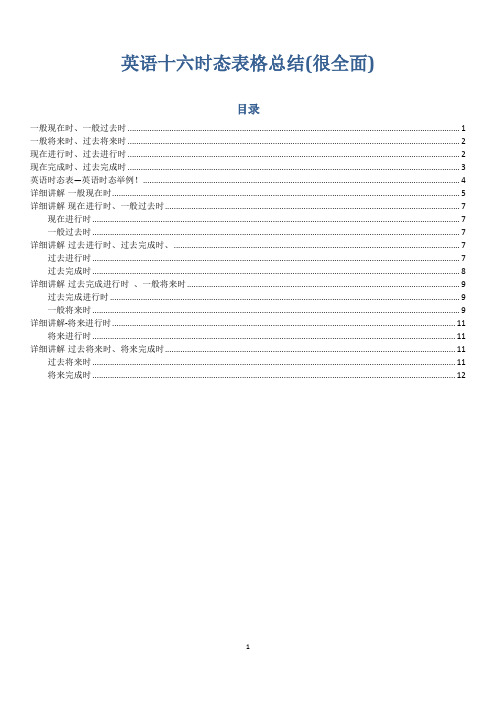
英语十六时态表格总结(很全面)目录一般现在时、一般过去时 (1)一般将来时、过去将来时 (2)现在进行时、过去进行时 (2)现在完成时、过去完成时 (3)英语时态表—英语时态举例! (4)详细讲解-一般现在时 (5)详细讲解-现在进行时、一般过去时 (7)现在进行时 (7)一般过去时 (7)详细讲解-过去进行时、过去完成时、 (7)过去进行时 (7)过去完成时 (8)详细讲解-过去完成进行时、一般将来时 (9)过去完成进行时 (9)一般将来时 (9)详细讲解-将来进行时 (11)将来进行时 (11)详细讲解-过去将来时、将来完成时 (11)过去将来时 (11)将来完成时 (12)英语共有16种时态!常用的有12个:一般现在时、一般过去时、一般将来时、过去将来时、现在进行时、过去进行时、将来进行时、现在完成时、过去完成时、将来完成时、现在完成进行时和过去完成进行时。
其他时态很少单独使用!下面发部分英语时态表吧!希望能对你们有帮助!一般现在时、一般过去时一般将来时、过去将来时现在进行时、过去进行时现在完成时、过去完成时英语时态表—英语时态举例!句子结构:主语+have/has doneI have studied English in severaldifferent countries.在一些国家,我已经学习了英语.I had studied a little English before I moved to the U.S.在我搬去美国之前,我已经学习了一点英语. I will have studied every tense by the time I finish this course.在我完成这个课程的时候,我已经能完成英语时态的学习了.句子结构:主语+be going to+have doneI’m going to have studied every tense bythe time I finish this course.同上.Present Perfect Continuous现在完成进行时Past Perfect Continuous过去完成进行时 Future Perfect Continuous将来完成进行时句子结构:主语+have/has beendoingI have been studying English for ten years.我已经学习英语有十年的时间了.句子结构:主语+had been doingI had been studying English for ten years before I moved to the U.S.在我搬去美国之前,我已经学习了十年的英语了. 句子结构:主语+will have been doingI will have been studying English for over three hours by the time youarrive.明晚你来的时候,我已经学习英语3个小时了.句子结构:主语+be going to have beendoingI’m going to have beenstudying English for over three hours by the time youarrive同上.详细讲解-一般现在时通常以动词原形表示。
英语八大时态标志词及结构表
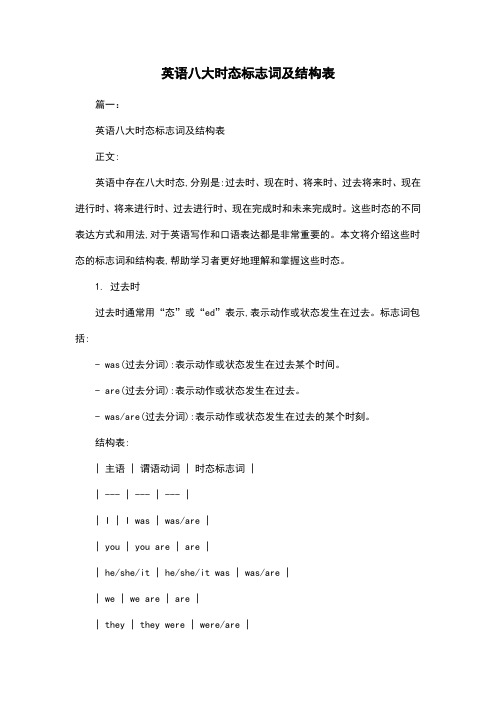
英语八大时态标志词及结构表篇一:英语八大时态标志词及结构表正文:英语中存在八大时态,分别是:过去时、现在时、将来时、过去将来时、现在进行时、将来进行时、过去进行时、现在完成时和未来完成时。
这些时态的不同表达方式和用法,对于英语写作和口语表达都是非常重要的。
本文将介绍这些时态的标志词和结构表,帮助学习者更好地理解和掌握这些时态。
1. 过去时过去时通常用“态”或“ed”表示,表示动作或状态发生在过去。
标志词包括:- was(过去分词):表示动作或状态发生在过去某个时间。
- are(过去分词):表示动作或状态发生在过去。
- was/are(过去分词):表示动作或状态发生在过去的某个时刻。
结构表:| 主语 | 谓语动词 | 时态标志词 || --- | --- | --- || I | I was | was/are || you | you are | are || he/she/it | he/she/it was | was/are || we | we are | are || they | they were | were/are |2. 现在时现在时通常用“态”或“ing”表示,表示动作或状态现在正在进行。
标志词包括:- am/is(现在分词):表示动作或状态现在正在进行。
- are(现在分词):表示动作或状态现在正在进行。
- was/are(现在分词):表示动作或状态现在正在进行。
结构表:| 主语 | 谓语动词 | 时态标志词 || --- | --- | --- || I | I am | am/is || you | you are | are || he/she/it | he/she/it is | is/are || we | we are | are || they | they are | are |3. 将来时将来时通常用“态”或“ing”表示,表示动作或状态将来会发生。
标志词包括:- will(将来分词):表示动作或状态将来会发生。
英语时态标志词文件.doc
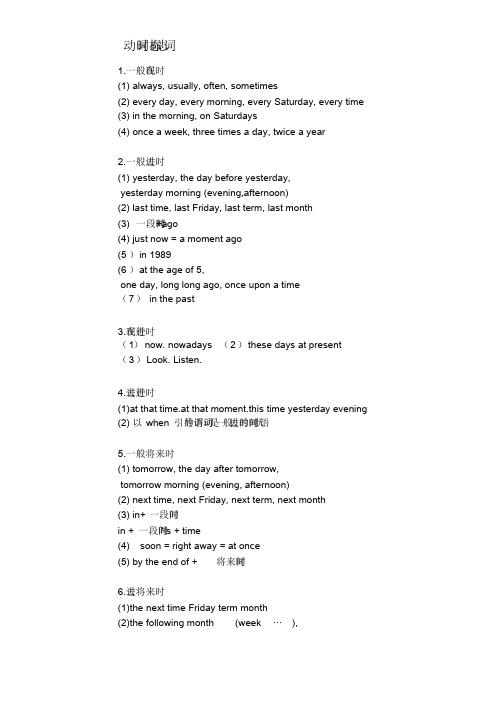
动词时态标志词1.一般现在时(1) always, usually, often, sometimes(2) every day, every morning, every Saturday, every time(3) in the morning, on Saturdays(4) once a week, three times a day, twice a year2.一般过去时(1) yesterday, the day before yesterday,yesterday morning (evening,afternoon)(2) last time, last Friday, last term, last month(3) 一段时间+ago(4) just now = a moment ago(5 )in 1989(6 )at the age of 5,one day, long long ago, once upon a time(7) in the past3.现在进行时(1) now. nowadays (2)these days at present(3)Look. Listen.4.过去进行时(1)at that time.at that moment.this time yesterday evening(2) 以 when 引导的谓语动词是一般过去时的时间状语5.一般将来时(1) tomorrow, the day after tomorrow,tomorrow morning (evening, afternoon)(2) next time, next Friday, next term, next month(3) in+ 一段时间in + 一段时间' s + time(4) soon = right away = at once(5) by the end of +将来时间6.过去将来时(1)the next time Friday term month(2)the following month (week ⋯ ),7..现在完成时(1) already, yet, ever, never, just, before(2) for + 一段时间,since +过去某一点时间since + 从句(一般过去式);since + 一段时间+ agoin / during the past / last + 一段时间(3)recently ,lately(4)so far8..过去完成时(1).by, by the time (of), by the end of +过去时间(2 )when. before. after ⋯⋯过去.时+间(3 )up till then ( 直到那时); up until last night( 直到昨晚)等。
常见时态标志词
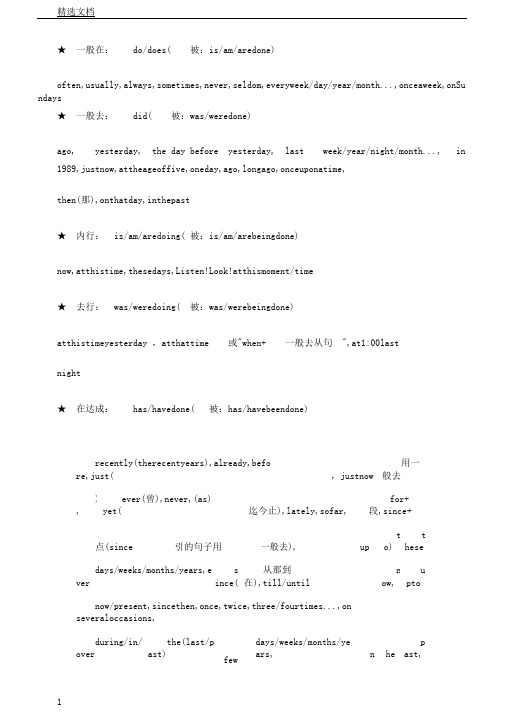
★一般在:do/does( 被:is/am/aredone)often,usually,always,sometimes,never,seldom,everyweek/day/year/month...,onceaweek,onSu ndays★一般去:did( 被:was/weredone)ago, yesterday, the day before yesterday, last week/year/night/month..., in1989,justnow,attheageoffive,oneday,ago,longago,onceuponatime,then(那),onthatday,inthepast★内行:is/am/aredoing( 被:is/am/arebeingdone)now,atthistime,thesedays,Listen!Look!atthismoment/time★去行:was/weredoing( 被:was/werebeingdone)atthistimeyesterday ,atthattime 或"when+ 一般去从句",at1:00lastnight★在达成:has/havedone( 被:has/havebeendone)recently(therecentyears),already,before,just(,justnow用一般去) ,ever(曾),never,(as)yet(迄今止),lately,sofar,for+段,since+点(since引的句子用一般去),(upto)thesedays/weeks/months/years,e versince(从那到在),till/untilnow,uptonow/present,sincethen,once,twice,three/fourtimes...,on severaloccasions,during/in/ overthe(last/past)(fewdays/weeks/months/years,nthepast,)It’sthefi rst/second/.../lasttime that⋯★去达成:haddone( 被:hadbeendone)before,bytheendof last year/term/month...( 与未来达成比)★一般未来:willdo( 被:willbedone)tomorrow,nextday/week/month/year...,soon,inafewminutes,by...,thedayaftertomorrow,inthefuture★过去未来时:woulddo( 被动:wouldbedone)thenextday/morning/year..., thefollowingmonth/week...★未来达成时:willhavedone( 被动:willhavebeendone) bytheendof nextweek/term/month...( 与过去达成时比较)。
- 1、下载文档前请自行甄别文档内容的完整性,平台不提供额外的编辑、内容补充、找答案等附加服务。
- 2、"仅部分预览"的文档,不可在线预览部分如存在完整性等问题,可反馈申请退款(可完整预览的文档不适用该条件!)。
- 3、如文档侵犯您的权益,请联系客服反馈,我们会尽快为您处理(人工客服工作时间:9:00-18:30)。
英语时态标志词动词时态标志词1.一般现在时(1) always, usually, often, sometimes(2) every day, every morning, every Saturday, every time(3) in the morning, on Saturdays(4) once a week, three times a day, twice a year2.一般过去时(1) yesterday, the day before yesterday,yesterday morning (evening, afternoon)(2) last time, last Friday, last term, last month(3) 一段时间+ago(4) just now = a moment ago(5)in 1989(6)at the age of 5,one day, long long ago, once upon a time(7) in the past3.现在进行时(1)now. nowadays (2)these days at present(3)Look. Listen.4.过去进行时(1)at that time.at that moment.this time yesterday evening(2)以when引导的谓语动词是一般过去时的时间状语5.一般将来时(1) tomorrow, the day after tomorrow,tomorrow morning (evening, afternoon)(2) next time, next Friday, next term, next month(3) in+一段时间in + 一段时间 ' s + time(4) soon = right away = at once(5) by the end of + 将来时间6.过去将来时(1)the next time Friday term month(2)the following month (week…),7..现在完成时(1) already, yet, ever, never, just, before(2) for + 一段时间,since + 过去某一点时间since +从句(一般过去式);since + 一段时间 + agoin / during the past / last + 一段时间(3)recently ,lately(4)so far8..过去完成时(1).by, by the time (of), by the end of + 过去时间(2)when. before. after…….+过去时间(3)up till then (直到那时); up until last night(直到昨晚)等。
(4)already, just, ever, yet 等英语单选常见时态类标志词1.It’s the first time that……….(从句中用现在完成时)It was for the first time that………(强调句,对状语for the first time进行强调)It’s (high) time that……..(从句中用过去时或should do)2.It’s the same with sb. / So it is with sb.表示某人也如此(用于前句中既有肯定又有否定或两个不同类的谓语动词)3.…be about to do / be doing……when…….正要做/正在做……就在那时…….4.A is twice / three times as +原级+as BA is twice / three times the n. of BA is twice / three times +比较级+than B5.It’s a waste of time / money doing / to do…It’s no use / good doing………It’s possible / probable / (un) likely that……….It makes great / no sense to do……做某事很有/没意义6.There’s no use / good doing…….There’s no sense / point (in) doing……There is no need for sth. / to do…….There is (no) possibility that…………(同位语从句)7.The+比较级…….., the+比较级………越……..,越…….注意:前半句为从句,用一般现在时代替将来时;8.It seems / appears ( to sb. ) that sb…….在某人看来某人………= Sb. seems / appears to be // to do / to be doing / to have done……..It seems / looks as if……….好象/似乎……..9.It (so) happened that sb. ……..某人碰巧……..= Sb. happened to be / to do / to be doing / to have done…..10.It is said / thought / believed / hoped / supposed…….that sb………=Sb. is said to be / to do / to be doing / to have done……….注意:这种句型里如带动词hope则不能变成简单句,因为hope sb. to do结构11.loading...12…….such…….that…….如此…….以致于(引导结果状语从句)…….such……..as……像……..的这种……(as为关系代词,引导定语从句,在从句里充当主、宾、表)13. Do you mind if I do sth.? / Would you mind if I did sth.?14. The chance is that……../ (The )Chances are that……….很可能…….15.Check / Make sure / See to it / See that……..(从句中常用一般现在时) 确信/务必……..16. depend on it that……..取决于see to it that…….负责/设法做到…….注意:除了except / but / in等介词可以直接接that从句,其它介词后必须用it做形式宾语;17.It is / was +介词短语/ 从句/ 名词/代词等+that………How / When / Where / Why is / was it that………..?注意:此句型为强调句,当被强调的为表示人的词时,还可用who 连接;强调主语时,从句后的谓语动词应与前面的主语保持一致;注意与定语从句的区别)18.How is it that……..How come+从句?How does / did sth. come about?( How did it come about that…….?)如:How come you are late again?(这几个句型都表示“怎么会…….?”“怎么发生的?”)19.There seems / appears / happens to bemust be / can’t be / is (are, was, were) said to beis (are, was, were) thought to be…….表示“.似乎有/碰巧有/一定有/不可能有/ 据说有/认为有……..”介词(如of )there being want / wish / expect there to be要/希望/期待有……..adj. / adv. enough for there to be…….足够…….会有…….注意:there being / there to be为there be的非谓语形式;It is said / thought that there is / are……=There is / was / are / were said (thought) to be…….如:I have never dream of there being such a good chance for me.It won’t be cold enough for there to be a frost tonight.20. 疑问词+插入语+陈述语序?Who do you think he’ll have attend the meeting?21. But for + n. / pron., sb. / sth. would (not) have done…..要不是……., 某人早就…… (表示虚拟语气)=If it had not been for…..,……./ If there had not been …….,……..22. It won(’t) be long before +从句(从句中用一般现在时)不久/很久就要…….It was (not) long before+从句(从句中用一般过去时)不久/很久才……..23.Those who………….(从句及主句中谓语动词用复数形式)Anyone who…………= Whoe ver………..(从句及主句中谓语动词用单数形式)24主句(一般现在时或过去时)…...when从句….(might / should do 或might / should have done)表示”对比”,意思为“本该……(可)而却”,主句中为陈述语气,从句里为虚拟语气,Why are you here when you should be in school?你本该上学的怎么在这儿?He stopped trying when he might have succeeded .本该已成功了他却停止努力了.25.There is ./ Sb. have no doubt that………(同位语从句,that不可省略)There is / Sb. have some doubt whether……..(同位语从句不可用if)Sb. doubt if / whether…….Sb. don’t doubt that………26.immediately / directly / instantly / the moment +从句on / upon + n. / doingNo sooner had sb. done than …….(过去时)Hardly had sb. done when……..(过去时)注意:这几个结构都表示“一…….就”;27.every time / each time /the last time / the first time / next time +从句(名词性短语引导时间状语句)anywhere / everywhere +从句(相当于wherever引导的地点状语从句)You can go anywhere you like.Next time you come, please bring your son along.28.If only / I wish +从句 (用过去类时态)表示虚拟语气, “要是…….就好了”“但愿……就好了!”29.Considering + n. 或 pron. 或 that从句 /Seeing that……….考虑到/鉴于…….Given + n. / pron作状语,表示“在有……的情况下”“如果有”“假定”,有时也表示”考虑到”Seeing (that) he refused to help us, there is no reason why we should help him now.Given good health, I hope to finish the work this year.Given their inexperience / that they are inexperienced, they’ve done a good job.30.There was a time when…….曾经有那么一度……….31.other than与no, not, none等否定词连用,表示肯定意思,如: It was none other than Mr. Smith.这正是Smith先生.32. Not until…….did / do/ does / will sb. do……It was / is not until ……that sb………33.It’s (un) like sb. to do / to have done……做某事很像某人/ 做某事可不像某人34.It remains to be seen whether……..是否…….还有待于看.(不用that, if作连接词)35.It only remains for sb. to do……剩下的只是要某人做某事.We’ve got everything ready.It only remains for you to come to dinner.35.One moment……., and now………刚才一会儿还在做……而现在却……..37.Not all / both / everyone………表示部分否定38. Such is / are……..这(些)就是……. (谓语动词单复数由后面名词决定)39.I’d rather (not) do / have done……我宁愿…..I’d rather +从句(从句中用过去时或过去完成时)40. It’s important / necessary / strange / surprising….+that……(用陈述语气或should do)41. I like / hate / appreciate it that / when等从句(it表示后面从句的这种情况)I appreciate it if you will give me a hand.42. By the time +从句(一般现在时/过去时),主句(将来完成时/过去完成时)43………., as is often the case with sb. / as is usual with sb.(as引导非限制性定语从句)44 in case / lest / for fear that…….(从句中用陈述语气或should do)45.While置于句首可表示As long as 或 AlthoughWhile there is life there is hope.While I admit his good points, I can see his bad ones.46.can not ( never) ……too +adj. (adv. ) / adj. (adv.) + enough “越……越好”“非常”too + adj. ( anxious / eager / willing / ready / glad等)+to do…表示肯定意思I can’t thank you enough.我非常感激你.He was too glad to see his father.=He was very glad to see his father.47. not / neve等表示否定的词与比较级连用表示最高级,-----Do you agree with his suggestion?-------I can’t agree more.48. What if……..要是…….怎么办?What if he doesn’t come tomorrow?49.more……..than与其…….不如……..He is more nervous than frightened.50. It is / has been +一段时间+since从句(从句中如为延续性动词,则实际表示的意思相反)It is two years since he drank.他不喝酒已两年了.。
